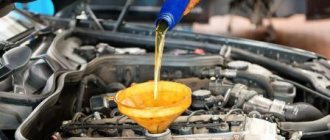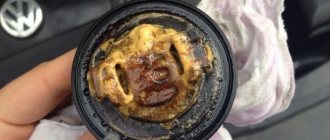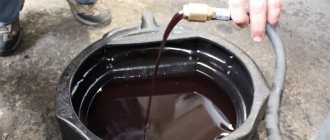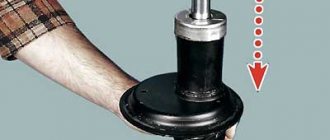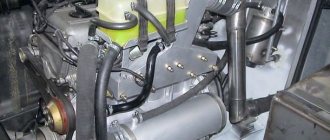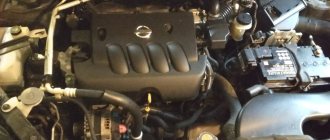Proper engine care is one of the most important tasks in car maintenance. Every owner who is attentive to his car knows that the performance of the car as a whole depends on the quality of service and functionality of the engine. Many car owners, when the time for scheduled maintenance of the car approaches, drive it to a service center, where specialists carry out all the necessary procedures in accordance with the regulations, however, there are also those who prefer to carry out simple service work on their own. In this article we will talk about the procedure for flushing the engine when changing the oil, the need for which has some controversy regarding the frequency of such a process and the type of flushing fluid. Let's consider whether flushing the engine with diesel fuel before changing the oil, which was used in ancient times and remains relevant today, is justified, let's talk about the advantages and disadvantages of this method of dealing with deposits in the power unit, and also tell you how to correctly carry out this procedure.
How to properly flush the engine before replacing diesel fuel.
Why do you need to flush the engine with diesel fuel?
The fact that it is necessary to change the engine oil according to the regulations is known to all car owners; it is explained by the loss of the lubricant’s protective properties during operation and a decrease in the efficiency of its operation. Many articles have been written about the regulations and the need to change the lubricant in the engine, however, it is rarely mentioned that before adding new lubricant it is necessary to wash the unit from the inside. How do professionals explain this need, and how often should the procedure be performed?
The need to flush the power unit arises in the following situations:
- Changing the type of engine oil. Today, the market for fuels and lubricants is very diverse, which provokes consumers to select more effective oils for their car, which differ not only in type, but also in composition. When draining the oil, even if the procedure is carried out very efficiently, a small amount of waste fluid remains in the units of the unit and on its walls, and when filling the system with new lubricant, a “conflict” may occur between the components of the motor oils, which will negatively affect the operation of the engine.
- Changing the oil after purchasing a car on the secondary market. A similar situation in which the owner knows what kind of fluid is in the engine only from the words of the seller. Before filling the engine oil, the engine must be cleaned of previous lubricant.
- Coolant entering the system as a result of gasket deformation.
- Engine overhaul. In this case, all structural components underwent contact cleaning and were manually assembled, which is often accompanied by the entry of small particles into the system, which can negatively affect the operating life of the unit.
These precedents necessitate mandatory flushing of the power unit. In addition, flushing the engine may be necessary if the car is operated in extreme or difficult conditions, high-speed and high-temperature conditions, which provokes the formation of scale on the internal surfaces of the unit, which blocks the oil passages. You can determine the need to flush the engine by inspecting the drained liquid: if there are large particles, flakes and sludge in the waste, you will need to clean the engine from the inside in order to remove components that are dangerous to the engine.
Nowadays, service center employees recommend flushing with special liquids that are designed to clean the power unit before changing the oil. Why then did the question of flushing with diesel fuel arise? Several decades ago, the number of cars on the country’s roads was much smaller, and not every family could boast of a personal car, and accordingly, the range of fluids for servicing the engine was limited to several types of oils and diesel fuel as a means for washing it. Today the market situation has changed, but the habit remains. Many car owners still wash their engines with diesel fuel themselves and recommend this procedure to others. Moreover, some explain this fact by savings, while others indicate the high efficiency of diesel fuel as a flushing liquid.
Today, the theory about the high usefulness and quality of engine flushing with diesel fuel has both adherents and opponents, and in almost equal quantities, which forces car owners to understand for themselves the pros and cons of such a procedure, and as a result, make an independent decision in favor of a flush emulsion - choose a modern liquid or give preference to diesel fuel.
Flaws
Result after manual washing. Using diesel fuel as a flushing liquid will not give this result.
For example, diesel fuel, being a fuel, does not dissolve slags and carbon deposits, but peels them off from the walls. These contaminants, which are not completely removed, circulate with fresh motor oil, impairing its beneficial properties. That is, exfoliated contaminants are poorly washed out completely when drained.
They pose a danger in that they clog lubrication channels and mesh, leading to decreased circulation and oil starvation of operating components. The use of flushing fluid with alkaline additives inevitably leads to damage to the rubber gaskets, oil seals, and seals. And this is a direct road to failure of the power unit.
Pros and cons of diesel fuel as a flushing fluid
Indeed, one of the advantages of diesel fuel in comparison with special means is the pricing policy. Flushing the engine with diesel fuel before changing the oil will be much cheaper than carrying out this procedure using purchased emulsions. The second argument in favor of diesel fuel is its use in all CIS countries for cleaning engines of domestically produced equipment, as well as its applicability for engines of special equipment. The effectiveness of this method is proven by the large number of domestically produced cars on the roads at the present time, which perfectly perform their functions despite their advanced age.
But the following fact casts doubt on the benefits of diesel fuel for the engine. Many users explain the effectiveness of diesel fuel when flushing the engine before changing the oil by the fact that it is actively used to clean engine elements during major repairs by professionals. And this is true, diesel fuel actively cleanses the elements of scale, dirt and sludge. However, opponents of the theory argue that when cleaning parts during a major overhaul, these components are not only affected by diesel fuel, but also a significant mechanical force is applied, due to which a positive result is achieved.
In addition, many experts note that when flushing the engine, diesel fuel does not break down the scale on the parts, but acts by peeling it off from the internal surfaces. Since it is almost impossible to completely remove these particles during the washing process, some of the coarse components will remain in the engine, and when oil is added, the particles will freely circulate through the system, causing damage to it and blocking small passages, thereby causing oil starvation of individual engine components. Additionally, doubts about the effectiveness of diesel fuel in cleaning the power unit are caused by the effect of the liquid on oil seals, gaskets and seals. Diesel fuel can cause their deformation, which will affect not only the functionality of the motor, but also its performance characteristics, and can cause its premature failure.
An impressive list of both positive characteristics of diesel fuel as a flushing fluid and negative factors makes you wonder whether it is possible to flush the engine with diesel fuel when changing the oil. There is no clear answer to this question. In practice, over the years of its use, diesel fuel has earned popularity in relation to the engines of domestically produced cars with significant mileage. Some owners of used foreign cars also actively use this method of cleaning the power unit and confirm its effectiveness. As for new or warranty cars, foreign cars with low mileage, engines of modern modifications, here the opinion of professionals is unequivocal - such a procedure is strictly prohibited, since it may not only not produce results, but also harm the engine. In addition, even for old cars, the procedure should be performed only when the need arises, but not at every oil change.
What to wash with?
A small list of engine washing liquids with a standard volume of 4 liters.
- ZIC FLUSH. This washing liquid has good cleaning properties. Safe for polymer sealing parts (oil seals). It has the ability to preserve the properties of fresh oil, preventing its oxidation.
- ENEOS FLUSH. Excellent cleaning properties. Capable of maintaining deposits in suspension, preventing clogging of oil channels.
- "Lukoil". Good quality/price ratio. It has a serious additive package with excellent anti-wear properties and dissolves old dirt well.
- "Lakiris." Product based on base oil with the addition of detergent and antioxidant additives. Gently dissolves sludge and carbon deposits and removes dirt well.
- TNK Promo Express. Popular engine flushing fluid. It is used by both garage mechanics and service stations.
The process of flushing the engine with diesel fuel
If, after weighing all the pros and cons, you decide to clean the engine with diesel fuel, you trust more in the experience of your ancestors, which has proven its effectiveness over the years, than in modern liquids, we will tell you how to carry out this procedure correctly and correctly. The methodology for flushing the engine with diesel fuel when changing the oil is not particularly complicated or requires significant investment. To complete this task, you will need to stock up on diesel fuel, in a volume of at least eight liters, two oil filters, one of which must be of high quality, preferably an original element for your car, the other can be the cheapest, since it will only be used when cleaning the power unit.
The procedure is carried out immediately after draining the used oil. It is recommended to drain the waste in a pit or overpass, on a warm engine, through the oil drain hole on the crankcase pan. Sometimes this will require removing the power unit protection, if it is provided by the vehicle modification. Detailed instructions for changing the fluid in the power unit for a specific car model can be found in the user manual or in articles on this topic on our website. After draining the used motor oil, you need to dismantle the worn-out oil filter and install a purchased filter element in its place.
The further task of the performer is to flush the engine as much as possible from dirt and sludge. To do this, the engine is first cleaned of coarse particles and oil residues by passing diesel fuel through the system. The oil drain hole is left open, and diesel fuel is poured into the filler opening with maximum pressure. It is important to first place a container for the waste liquid under the drain hole. To complete this procedure, you will need about three liters of liquid.
The next step is a better cleaning of the unit components and hard-to-reach areas. For this purpose, the drain opening is closed and diesel fuel is poured in in a volume equal to the amount of motor oil in the car engine. Next, you need to start the car and drive the flushing emulsion through the system, maintaining speed, but without bringing the power unit to operating temperatures. This point is very important, since at high speeds diesel fuel will not be able to cope with the assigned tasks, causing harm to the contacting parts.
After this procedure, the flushing liquid is drained, and the quality of the flowing emulsion is visually monitored. If the diesel fuel comes out too contaminated, with particles of sludge, it is important to carry out this procedure again. Flushing should be carried out until clean fuel begins to flow out of the drain hole, without any impurities in it. At this stage, engine flushing can be considered complete. Next, you should replace the temporary oil filter with a new, original product, tighten the drain cap tightly, having previously cleaned it of dirt and accumulations, and, if necessary, change the seal between the opening and the plug, if it is provided for by the design. The final stage is pouring new motor oil into the vehicle engine. After replacing the lubricating emulsion, it is important to break in the engine - drive the car for about five kilometers in a quiet mode, check the oil level again, if necessary, add it to the level, inspect the butt joints for lubricant leaks.
Since diesel fuel does not have sufficient cleaning and lubricating properties, which are required for the normal functioning of the engine, for the first few kilometers, until the oil is distributed evenly among the components, it is important not to operate the vehicle in an aggressive mode. To eliminate the danger of abrasion of contacting elements, some car owners recommend flushing the engine not with pure diesel fuel, but diluted in equal proportions with inexpensive motor oil, however, the feasibility of such a procedure has not been proven.
What to wash with?
If good oil is poured into the engine, then there is no chance of deposits forming.
However, flushing the internal cavity of the engine clean is questionable. The cylinder block has channels, hard-to-reach labyrinths, from which it is difficult to remove diesel fuel used as a flushing liquid. So, you need to stock up on five liters of diesel fuel or kerosene and a filter (not expensive).
Mixed oil and diesel fuel in a ratio of 60/40
Motor oils contain additives with detergent, anti-corrosion, antioxidant, and extreme pressure properties. They are not prone to the formation of deposits and dirt. Many of them are retained by the filter, and some are discharged through the crankcase drain hole. Deposits accumulate if different brands of oil are used.
That is, the remaining contaminants, mixing with the engine oil, precipitate, forming deposits. Frequent overheating of the engine leads to the formation of these, causing decomposition of the motor fluid. As a result, coke deposits that are difficult to wash off and sometimes cannot be removed appear on the inner walls of the block. The situation comes down to the rapid depletion of the lubricant life.
What's better
GZox Flushing Oil
It is preferable to use flushing fluids for the engine. Their range differs in additive components.
- FlushOil - is poured after draining the waste. It is recommended to operate the car for 50÷500 km before filling with new oil.
- EngineFlush - used after removing the old one. Can be added to the oil in the pan. It is advisable to let the machine idle for a few minutes.
- Cleaning additives are poured into the engine 3-4 days before replacement. They have the ability to penetrate everywhere, splitting and dissolving sludge and slag.
Meanwhile, there is no consensus regarding flushing oils. Doubts are raised by aggressive (alkaline) additives, which unsatisfactorily clean coked deposits of dirt within a few minutes of engine operation. And aggressive compounds lead to corrosion of rubber seals.
Let's sum it up
Diesel oil has been used by car owners for many decades as an effective and gentle means for washing the power unit. Today, the effectiveness of the diesel fuel flushing procedure is questioned by many automakers and service center employees; alternatives are considered to be the use of specific liquids to clean the engine. However, a detailed study of the composition of special emulsions for washing the engine raises doubts and controversial issues, since effective removal of soot and dirt using special liquids is achieved due to the presence of aggressive chemical components in them, which can also negatively affect the unit components.
As many years of practice have proven, the method of flushing the engine with diesel fuel has a right to exist, is characterized by high efficiency against the backdrop of low costs, and is considered a gentle way to clean the engine. Each car owner has the right to decide independently which product to choose; however, when performing the flushing, you should act very carefully, follow the instructions, do not overheat the engine - and the result will live up to expectations. Better yet, keep an eye on the engine of your car, try to avoid overheating and stress, change the oil in a timely manner - and the engine will not need such procedures.
Features of the washing procedure
The main reason for washing the engine with diesel fuel is to completely cleanse the internal combustion engine of past lubricant and contaminants. Often, liquids are used for cleaning that can dissolve solids, resin and old oil residues. Usually, special additives are added to the car oil before draining. You can also fill in the flushing agent after draining the used consumables. Today's flushes perform their task well, but they are expensive and considered quite aggressive. If they are added to the engine, they can destroy its parts.
Modern service – is it worth experimenting?
Cleaning the engine using solarium was still somehow appropriate in those distant Soviet times, when the quality of the oil left much to be desired, and the engines that were washed were developed back in the days of dear Leonid Ilyich, i.e. in the 70s of the 20th century. Today, when there are a huge number of modern cars on the roads, equipped with even more high-tech computerized systems, washing with diesel fuel is more like heresy than the truth.
If you, for example, tell a German or, God forgive me, an American about this, he will probably have a heart attack. After all, when you pay more than 50 thousand euros for a car and at the same time at a certain hour you begin to wash something in your garage with something... The first thing that happens is the loss of the warranty on the car and surprised looks in the back of the home-grown auto mechanic.
